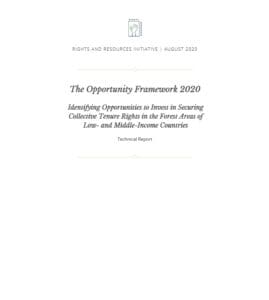Date: September 15, 2020
Indigenous Peoples, local communities, and Afro-Descendant Peoples (IP, LC & ADP) — roughly 2.5 billion people — customarily manage over 50% of the global land mass, but governments currently recognize their legal ownership to just 10% (RRI, 2015). Fortunately, there has been progress in addressing this historic injustice in recent years as governments have begun to pass legislation and achieve court decisions to recognize the historic and customary use and ownership of these lands. A recent stock-taking finds that since 2002, at least 14 additional countries have passed legislation that require governments to recognize these rights. Similarly, there have been positive national and regional level court decisions in numerous countries supporting the formal recognition of the collective land and forest rights of Indigenous Peoples, local communities, and Afro-descendant Peoples. RRI research demonstrates that if only 7 countries implemented these new laws, policies, and court decisions, over 176 million hectares would be transferred from government to Indigenous, local community, and Afro-descendant ownership, benefitting over 200 million people (RRI, 2018).
The progress on the legal front demonstrates the exceptional opportunity for countries and the global community to address this long-standing abuse of human rights. Unfortunately, legal frameworks for recognition of collective tenure rights are often not implemented, as governments and their societies often lack the financial resources, organizational capacities, or political interest to implement these laws and court decisions. This agenda has also never been a high priority of the international development community – though there is a history of investment by some multi-and bilateral donors in collaboration with governments and local communities that has generated important experience and lessons.
Increased understanding and appreciation in recent years of the role of secure Indigenous and community land rights in protecting forests and ecosystems has generated new interest, and new possibility, to make progress on this long-standing human rights crisis. Research shows that legally recognized Indigenous and community lands and territories store more carbon, have lower emissions, and have significantly lower deforestation rates than lands owned by other actors and cost less to establish and maintain than conventional protected areas. It is now well recognized by the global scientific community as well as climate and biodiversity conservation sectors that insecure, contested, and unjust land and forest tenure undermines international efforts to protect, sustainably manage, and restore ecosystems essential to the realization of climate, conservation, and sustainable development goals.
For these reasons, a growing number of governments and development organizations are increasingly interested in identifying opportunities to accelerate and scale-up the recognition and strengthening of Indigenous Peoples’, Afro-descendant Peoples’, and local communities’ rights over their forests, lands, territories, and resources.
The purpose of this report is to facilitate greater investment by governments, development, climate, and conservation organizations in projects to formally recognize the land and forest rights of local communities, Afro-descendant Peoples, and Indigenous Peoples. This report is an independent, and expert, high-level scan of the status of country readiness for investments to secure these rights, prioritizing countries that are members of the Forest Carbon Partnership Facility (FCPF), an international initiative to help governments reduce deforestation and thereby mitigate climate change. This report is designed to facilitate awareness and identify potential opportunities for investment by these and other governments, the supporters of the FCPF, and other potential donors, and provide a simple framework for monitoring the status of readiness for such investments over time. This “Opportunity Framework” enables an open access tracking of country and global progress on the global imperative of recognizing local peoples’ collective land rights. The assessments are intentionally independent to increase the objectivity and candidness of the analysis and judgements, and thereby give an unvarnished view of the current situation in each country.
The logic of this report, and the Opportunity Framework tool itself, is that the results of this scan are indicative rather than deterministic. It is hoped that, depending on the interest of the potential donor or government, they would invest greater effort in conducting further due diligence before choosing to invest. Following this same logic, this report is followed by a second, deeper and more operational, analysis of these same questions in collaboration with the FCPF, for a selected set of FCPF member countries. The results of this work will be posted on a website and regularly updated to continue to provide information to those interested in investing in securing Indigenous Peoples’, local communities’, and Afro-descendant Peoples’ forest and land rights.
The focus of this report, and the Framework itself, is limited to formal recognition of land and forest rights (i.e. delimitation, mapping, registry, etc.). It does not assess the important and subsequent steps of strengthening community or territorial governance, the enforcement of these rights by governments, or the capacities necessary to enable Indigenous, local community, and Afro-descendant organizations to manage or exploit their resources or engage in enterprises or economic development activities – all of which are essential for sustained and self-determined conservation and development. This Framework focuses on the first step in this longer process.
https://doi.org/10.53892/RHAA9312

